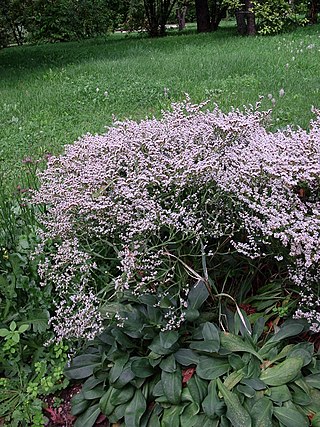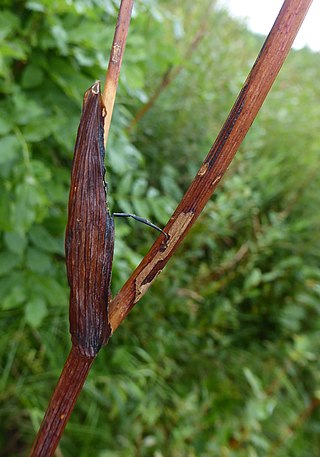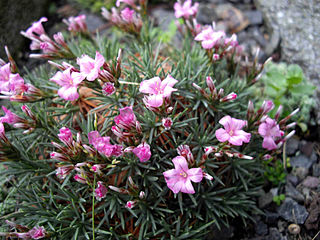
Plumbaginaceae is a family of flowering plants, with a cosmopolitan distribution. The family is sometimes referred to as the leadwort family or the plumbago family.

Limonium is a genus of about 600 flowering plant species. Members are also known as sea-lavender, statice, caspia or marsh-rosemary. Despite their common names, species are not related to the lavenders or to rosemary. They are instead in Plumbaginaceae, the plumbago or leadwort family. The generic name is from the Latin līmōnion, used by Pliny for a wild plant and is ultimately derived from the Ancient Greek leimon.

The genus Fagopyrum is in the flowering plant family Polygonaceae. It includes some important food plants, such as F. esculentum (buckwheat) and F. tataricum. The genus is native to the Indian subcontinent, much of Indochina, and central and southeastern China. Species have been widely introduced elsewhere, throughout the Holarctic and parts of Africa and South America.

Fagopyrum tataricum, also known as Tartary buckwheat, green buckwheat, ku qiao, Tatar buckwheat, or bitter buckwheat, is a domesticated food plant in the genus Fagopyrum in the family Polygonaceae. With another species in the same genus, common buckwheat, it is often counted as a cereal, but the buckwheats are not closely related to true cereals.

Acantholimon is a genus of small flowering plants within the plumbago or leadwort family, Plumbaginaceae. They are distributed from southeastern Europe to central Asia, and also cultivated elsewhere in rock gardens.

Acer ginnala, the Amur maple, is a plant species with woody stems native to northeastern Asia from easternmost Mongolia east to Korea and Japan, and north to the Russian Far East in the Amur River valley. It is a small maple with deciduous leaves that is sometimes grown as a garden subject or boulevard tree.

Acer tataricum, the Tatar maple or Tatarian maple, is a species of maple widespread across central and southeastern Europe and temperate Asia, from Austria and Turkey east as far as Japan and the Russian Far East. The species is named after the Tatar peoples of southern Russia; the tree's name is similarly commonly also misspelled "Tartar" or "Tartarian" in English.

Ixiolirion is a genus of flowering plants native to central and southwest Asia, first described as a genus in 1821. Recent classifications place the group in the monogeneric family Ixioliriaceae in the order Asparagales of the monocots. In earlier systems of classification, it was usually placed in the family Amaryllidaceae.

Conioselinum is a genus of flowering plant in the family Apiaceae, native to Eurasia and North America. Its species are erect perennial plants with deeply toothed compound leaves and umbels of white flowers. Plants of this genus are known commonly as hemlock-parsley.
Acantholimon koeycegizicum, is a species of plant belonging to the family Plumbaginaceae.
Acantholimon karamanicum is a species of flowering plant. It grows on calcareous mountain slopes in Ermenek.

Acantholimon libanoticum(Lebanese prickly thrift, غملول لبناني) is a plant in the family Plumbaginaceae first described by Pierre Edmond Boissier. It is native to Western Asia from Turkey to Syria and Lebanon.

Goniolimon, sometimes called the statices, are a genus of flowering plants in the leadwort and plumbago family Plumbaginaceae, native to northern Africa, southern Europe, western and central Asia, Siberia, Mongolia and China. Low-lying perennial shrubs, some species are cultivated as ground covers.

Goniolimon tataricum is a species of flowering plant in the genus Goniolimon, family Plumbaginaceae. It is called German statice, Tatarian sea-lavender, Tartarian statice or just statice. It is native to Albania, Algeria, Bulgaria, Greece, Kazakhstan, the North Caucasus, Romania, Southern Russia, Tunisia, Ukraine and the former Yugoslavia. It is planted in gardens as a border and ground cover, and also used in the cut flower industry.

Conioselinum tataricum is a species of flowering plant belonging to the family Apiaceae.
Acantholimon acmostegium is a species of Plumbaginaceae that occurs in Iran. The species was described by Pierre Edmond Boissier and Friedrich Alexander Buhse in 1860.
Acantholimon acanthobryum is a species of flowering plant in the Plumbaginaceae family. The species is epidemic to Ghazni, Afghanistan and was discovered by Rech.f. & Schiman-Czeika.

Acantholimon ulicinum, also known as the prickly thief, is a species of broadleaf evergreen plants in the family Plumbaginaceae. Acantholimon ulicinum is around 10 cm (4 in) tall and has a spread of 30 cm (1 ft). The species is endemic to the eastern Mediterranean region where it grows in dry soil. From June to July is when Acantholimon ulicinum blooms, with pale pink flowers. It has crowded, rigid, hard-textured, spiny-tipped, linear and needle-like leaves, and five-petaled pink flowers in short-stalked inflorescences.
Acantholimon collare is a species of flowering plant in the Plumbaginaceae family described by Mogens Engell Köie and Karl Heinz Rechinger. The native range of this species is North East Iran. A phytochemical analysis from the University of Birjand found that the antimicrobial nature of compounds found in A. collare make it potentially suitable for pharmaceutical use.












